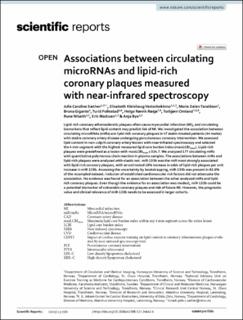| dc.contributor.author | Sæther, Julie Caroline | |
| dc.contributor.author | Vesterbekkmo, Elisabeth Kleivhaug | |
| dc.contributor.author | Taraldsen, Maria Dalen | |
| dc.contributor.author | Gigante, Bruna | |
| dc.contributor.author | Follestad, Turid | |
| dc.contributor.author | Røsjø, Helge Rørvik | |
| dc.contributor.author | Omland, Torbjørn | |
| dc.contributor.author | Wiseth, Rune | |
| dc.contributor.author | Madssen, Erik | |
| dc.contributor.author | Bye, Anja | |
| dc.date.accessioned | 2023-11-10T13:23:33Z | |
| dc.date.available | 2023-11-10T13:23:33Z | |
| dc.date.created | 2023-05-30T12:35:10Z | |
| dc.date.issued | 2023 | |
| dc.identifier.citation | Scientific Reports. 2023, 13, 7580 | en_US |
| dc.identifier.issn | 2045-2322 | |
| dc.identifier.uri | https://hdl.handle.net/11250/3101936 | |
| dc.description.abstract | Lipid-rich coronary atherosclerotic plaques often cause myocardial infarction (MI), and circulating biomarkers that reflect lipid content may predict risk of MI. We investigated the association between circulating microRNAs (miRs) are lipid-rich coronary plaques in 47 statin-treated patients (44 males) with stable coronary artery disease undergoing percutaneous coronary intervention. We assessed lipid content in non-culprit coronary artery lesions with near-infrared spectroscopy and selected the 4 mm segment with the highest measured lipid core burden index (maxLCBI4mm). Lipid-rich plaques were predefined as a lesion with maxLCBI4mm ≥ 324.7. We analyzed 177 circulating miRs with quantitative polymerase chain reaction in plasma samples. The associations between miRs and lipid-rich plaques were analyzed with elastic net. miR-133b was the miR most strongly associated with lipid-rich coronary plaques, with an estimated 18% increase in odds of lipid-rich plaques per unit increase in miR-133b. Assessing the uncertainty by bootstrapping, miR-133b was present in 82.6% of the resampled dataset. Inclusion of established cardiovascular risk factors did not attenuate the association. No evidence was found for an association between the other analyzed miRs and lipid-rich coronary plaques. Even though the evidence for an association was modest, miR-133b could be a potential biomarker of vulnerable coronary plaques and risk of future MI. However, the prognostic value and clinical relevance of miR-133b needs to be assessed in larger cohorts. | en_US |
| dc.language.iso | eng | en_US |
| dc.publisher | Springer Nature | en_US |
| dc.rights | Navngivelse 4.0 Internasjonal | * |
| dc.rights.uri | http://creativecommons.org/licenses/by/4.0/deed.no | * |
| dc.title | Associations between circulating microRNAs and lipid-rich coronary plaques measured with near-infrared spectroscopy | en_US |
| dc.title.alternative | Associations between circulating microRNAs and lipid-rich coronary plaques measured with near-infrared spectroscopy | en_US |
| dc.type | Peer reviewed | en_US |
| dc.type | Journal article | en_US |
| dc.description.version | publishedVersion | en_US |
| dc.source.volume | 13 | en_US |
| dc.source.journal | Scientific Reports | en_US |
| dc.source.issue | 1 | en_US |
| dc.identifier.doi | 10.1038/s41598-023-34642-6 | |
| dc.identifier.cristin | 2150152 | |
| dc.source.articlenumber | 7580 | en_US |
| cristin.ispublished | true | |
| cristin.fulltext | original | |
| cristin.qualitycode | 1 | |

